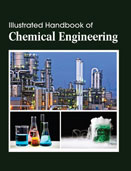Handbooks

This illustrate text provides a quick and convincing point of reference for chemical engineering, covering areas such as materials, energy balances, reactions, and separations. Chemical engineering is the study and practice of transforming substances at large scales for the tangible improvement of the human condition. Such transformations are executed to produce other useful substances or energy, and lie at the heart of vast segments of the chemical, petroleum, pharmaceutical and electronic industries. Chemical engineering differs from chemistry mainly in the focus on large scales. Chemical engineering embraces an enormous range of size scales in a fully integrated way ? ranging from atoms to oil tankers. The face of chemical engineering is changing, and we seek to mold that change for the common good.
Chemical engineering is the branch of engineering that deals with chemical production and the manufacture of products through chemical processes. This includes designing equipment, systems and processes for refining raw materials and for mixing, compounding and processing chemicals to make valuable products. Chemical engineers apply the principles of chemistry, biology, physics and math to solve problems that involve the production or use of chemicals, fuel, drugs, food and many other products.
Illustrated Handbook of Chemical Engineering provides authoritative point of reference for chemical engineering, covering areas such as materials, energy balances, reactions, and separations.
Food industry is using all operations and methodologies used by other industries for the production of safe food products such as heat sterilization, drying, refrigeration, concentration, membrane-based separation, milling, centrifugation, blending, pneumatic conveying, fluid flow, process modeling, monitoring, & control, powder & bulk-solid mixing. To give flavor, appearance, texture, nutritional value, the safety of different foods use the cooking over the fire, steaming, smoking, fermenting, sun drying, baking, or preserving with salt or spices. All these processes are the part of the chemical engineering. All these approaches are improving the aesthetic appeal of food, enabling longer distance transport for the multi-seasonal availability of some foods, and extending the shelf life of the foods. It also removes the microorganisms that are responsible for the food-borne illnesses. To complete the processing, the food industry needs chemical engineer experts, geneticists, chemists, and other experts in chemical engineering that help them to provide safety to the foods. Chemical engineering occupies a unique position at the interface between molecular sciences and engineering. Intimately linked with the fundamental subjects of chemistry, biology, mathematics, and physics — and in close collaboration with fellow engineering disciplines like materials science, computer science, and mechanical, electrical, and civil engineering — chemical engineering offers unparalleled opportunities to do great things. Traditionally linked to fuel combustion and energy systems, today’s chemical engineers are spearheading new developments in medicine, biotechnology, microelectronics, advanced materials, energy, consumer products, manufacturing, and environmental solutions. A new generation of chemical engineering-trained entrepreneurs are forming innovative new businesses. The task of chemical process development in the pharmaceutical industry has grown into a multidisciplinary endeavor requiring years to complete. Increased competition in the pharmaceutical additionally, the ever-tightening regulatory environment further compromises the business objective. This has required careful analysis of the activities within development.
Illustrated Handbook of Chemical Engineering shows how a balance between minimal resource utilization and phased development achievements can be reached. The cycle of development, from inception to completion, is examined. Special emphasis is placed upon the role of chemical engineering and its appropriate deployment. This book is recommended to students, chemical engineers, historians of chemistry, and to all persons interested in the development of chemical engineering.